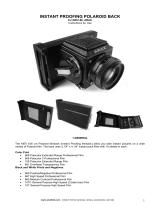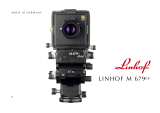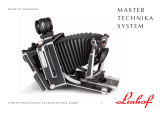Polaroid 545i - Camera Film Back User manual
- Category
- Microscopes
- Type
- User manual
This manual is also suitable for


Type 55 P/N

545i
4x5 Film Holder
English (only)
pages 4-10

Parts (Illustration 1)
a Focal plane
b Steel processing rollers
c Rubber light seal roller
d Hinged roller cover
e Roller hooks
f Film slot
g Control arm
h Film release lever
i Instruction label
Free and rapid technical
assistance: Call toll-free, Mon.-Fri.,
8 AM to 8 PM (Eastern Time).
From anywhere in the U.S.A. call
I-800-225-1618.
Introduction
The Polaroid Model 545i 4x5 Film
Holder enables you to use
Polaroid 4x5 sheet films in most
4x5 field or view cameras that are
equipped with spring backs, lock
backs and similar backs, without
making any alteration to the
camera or focusing system. It also
can be used with instruments
(such as microscope and
oscilloscope cameras) equipped
with similar backs, and with the
Polaroid MP-4+ and MP-4
cameras, the CU-5 4x5 camera
(88-45) and Polaroid Miniportrait
4x5 cameras.
Important: When the holder is not
in use, leave the control arm at P
(as shown in illustration 1).
The numbers throughout the text
refer to the illustrations at the
end of the book.
English 4

English 5
Polaroid instant 4x5 sheet
films
The actual image area of these
films is approx. 3
1
/2 x 4
1
/2 in.
(9 x 11.5cm), and is off-center
about
1
/8 in. (3mm) toward the
thick end of the holder. This area
is marked on the ground glasses
for the MP 4+ and MP-4 cameras,
but may not correspond precisely
with the area marked on other
ground glasses. For extreme
accuracy in composition, make
test shots and mark the exact area
on your ground glass.
Type 52 panchromatic black and white film for
general-purpose photography.
Type 53 panchromatic black and white coaterless film for
general-purpose photography.
Polapan PRO 100 panchromatic black and white coaterless film for
(Type 54) professional photographic proofing.
Type 55 P/N panchromatic black and white film that produces both
a positive print and a recoverable negative.
Type 57 high-speed panchromatic black and white film.
Type 59 Polacolor ER (Extended Range) color print film,
balanced for daylight and electronic flash (5500°K).
Polacolor PRO 64 color print film balanced for longer exposure times
Tungsten with tungsten/halogen light sources (3200°K)
Polapan 400 panchromatic black and white coaterless film for
general-purpose photography.
Polacolor PRO 100 color print film for studio and general-purpose
photography; balanced for daylight and electronic
flash (5500°K)

English 6
Attach the holder to the
camera
Before use, open the roller cover
and inspect the processing rollers.
Clean them if necessary (see
Cleaning the rollers).
Slide the
holder into the back of the
camera, just as you would a
standard film holder. If your
camera has slide locks, use them
in addition to the spring back; the
locks fit into slots on the sides of
the holder.
Make the exposure
1 Gently withdraw the envelope
from the holder until it comes to a
firm stop (7). It will come out
almost 6 inches (15cm), then stop.
The negative will remain inside
the holder, ready for exposure.
To prevent possible light leak,
the envelope should not be
removed for longer than
necessary. If outdoors, protect the
envelope from bright sunlight and
also from bending in the wind.
2 Lightly run your thumb and
forefinger over the area marked
DO NOT PRESS HERE (8). It
should be perfectly flat and smooth.
If you can feel the pod, the negative
was withdrawn accidentally with
the envelope. Push the envelope
in again, withdraw it, and check
again.
Load the film
1 Move the control arm to L (2).
2 Hold the envelope as shown (3)
and insert the cap end into the
holder. Be sure that the side
marked THIS SIDE TOWARD LENS
faces the lens. Do not hold the
envelope by the end when first
inserting it into the holder, as you
may buckle the envelope (4) and
damage the film.
Do not press on the area
marked DO NOT PRESS HERE,
where the pod of developer
chemicals is located.
3 Push the envelope in halfway (5),
then shift your grip to the end,
and push it in the rest of the way
(6). When the envelope is fully
inserted the tabs (6-j) will be
visible in the recess along the
edge of the film holder.

English 7
3 Make the exposure. The
recommended exposure meter
setting is printed on the film
envelope.
4 Push the envelope all the way in
(9). Use moderate pressure, but
don’t force it. If the envelope will
not slide in all the way, withdraw
it slightly and try again.
The exposed film is now ready to
be processed.
down to the metal cap (13). With
your left thumb hold down the
negative and thin paper mask,
and with your right hand quickly
lift off the print (14). It will come
right out of the envelope.
With the exception of Type
55P/N film*, the negative serves no
further purpose. Discard it with
the envelope.
*
The Type 59 negative is used for
Image Transfer.
Avoid contact with the chemicals
that remain on the negative. See
Caution
notice.
Processing Polaroid
instant films
1 Move the control arm to P (10).
2 Grip the envelope firmly, and pull
it straight, all the way out of the
holder (11). Pull smoothly, at
medium speed, without slowing
down or stopping. You will feel a
slight resistance when the metal
cap reaches the rollers, but continue
pulling without hesitation. The
rollers will separate to allow the cap
to pass through.
3 Wait the recommended
processing time. The film
instructions contain full details.
Temperature affects processing
time; at lower temperatures, the
time must be extended.
4 Remove the picture from the
envelope: Grip both tabs with
your thumbs as shown (12-k).
Roll both flaps back slightly.
Using moderate pressure, tear
the envelope open all the way

English 8
Type 55P/N film only: Use your
left thumb to hold down the
negative. With your right hand,
quickly peel away the print and
thin paper mask (15). Pull hard,
and the print and mask will
separate completely from the
negtive section and cap. Remove
the mask from the print and
discard the mask.
Complete instructions on
removing the negative from the
envelope and preparing it for
enlargement are in the film
instructions.
To remove instant film for
later processing
After exposure, reinsert the
envelope; push it in very firmly to
ensure that it engages the metal
cap at the end of the negative. Do
not move the control arm to P.
Leave it at L.
Remove the film holder from the
camera. Depress the film release
lever R (16-l). Keep the lever
Disengage the hooks (19-m) at
the ends of the rollers. The top
roller will swing up to permit easy
cleaning of the entire assembly
(20).
4 Clean the rollers with a soft,
lint-free cloth, dampened with
water if necessary. Rotate the
rollers as you clean and inspect
them. Also clean the rubber light
seal roller. Never scrape the
rollers with anything metallic, nor
with your fingernail.
5 Replace the top roller, engage the
hooks, then snap the cover closed.
depressed throughout the 3
following procedure.
3 Hold the film holder in one hand
with the opening in the film plane
facing you. With the thumb of the
other hand, gently push the film 4
envelope out as shown (17) until
the metal cap is visible. Then
grasp the end of the envelope and
pull it out.
To process the film, carefully
reinsert the envelope into the film
holder as when first loading,
move the control arm to P, and 5
process it as described above.
Cleaning the rollers
Dirt on the two steel processing
rollers can cause repeated spots
on the print and poor colors.
Check regularly to see that the
rollers are clean and free of
foreign matter.
1 Move the control arm to L.
2 Grip the hinged roller cover as
shown (18) and pull upward to
open the cover.

English 9
Possible picture problems
No exposure:
A completely black
picture indicates that no light
reached the negative. Check that
your equipment is functioning
(shutter, flash sync, etc.). This also
can be caused by failure to insert
the film envelope all the way into
the holder when loading the film;
failure to withdraw the envelope
before exposing the film; or
failure of the holder to catch the
metal cap when the envelope was
inserted.
Check the film loading
instructions. If this trouble occurs
frequently, check the film holder
for possible malfunction.
Black edge:
Failure to withdraw
the protective envelope fully
before making an exposure will
produce a black strip along the
edge of the picture. Always
withdraw the envelope as far as
possible before exposing the film.
Mechanical problems
Detached envelope:
If the film is
loaded backwards, the envelope
will detach completely when
withdrawn for exposure. To gain
access to the negative (which
remains inside the holder), open
the hinged cover and disengage
the rollers just as you would for
cleaning. Move the control arm to
P and withdraw the negative by
pulling the negative tab.
Jammed metal cap:
If the
negative (and metal cap) cannot
be removed from the holder as
described above, you can
disassemble the holder as follows:
1 Move the control lever to L.
2 Insert a small flat-head screw-
driver into the slot below the side
clip (21), and twist it to pry off the
clip (22). Remove both side clips.
3 Tilt the back panel up, then
remove it from the film holder (23).
Remove the jammed cap and
negative.
Missing corners:
With black and
white film, this can be caused by
pulling too fast; with color film it
can be caused by pulling either
too fast or too slowly. Pull straight,
at medium speed, without
hesitation.
Spots:
Deposits of dirt or foreign
matter on the steel rollers will cause
evenly spaced spots or marks
across the length of the picture.
Inspect and clean the rollers
regularly (see Cleaning the
rollers).
Streaks:
If your pulling motion is
uneven or jerky when removing
the film envelope, the rollers will
leave impressions across the
picture in the form of vertical
streaks. Always pull smoothly,
without hesitation.

Caution
The Polaroid instant film process
uses a caustic paste. Avoid contact
with skin, eyes and mouth and keep
away from children and animals. If
you get some paste on your skin,
wipe it off immediately and wash
with water to avoid an alkali burn.
If eye or mouth contact occurs,
quickly wash the area with plenty of
water and see a doctor. Keep
discarded materials away from
children, animals, clothing and
furniture.
Warranty
Your Polaroid Model 545i Film
Holder has been thoroughly
tested and inspected before ship-
ment. All parts are guaranteed
against defects in materials and
workmanship for one full year
from the date of original purchase.
During this period, any such defects
will be remedied by Polaroid
Corporation without charge, except
for transportation costs.
Damage resulting from normal
wear, mishandling or accident will
be promptly repaired at a reason-
able charge. To make returns, pack
the holder carefully in its original
shipping carton or other sturdy
container with plenty of padding
and ship it prepaid to the nearest
Polaroid Office.
4 To replace the back panel, insert
the end of the panel under the lip
of the roller cover (24-n), then
lower the panel into position.
5 Hold the back panel in position,
and replace the side clips (25).
Metal cap and envelope
misaligned: If mishandled, the
envelope and the metal cap may
become misaligned (26). If the
cap and tape on the back of the
envelope are not parallel, tap the
length of the cap lightly against a
flat, solid surface.
English 10




-
 1
1
-
 2
2
-
 3
3
-
 4
4
-
 5
5
-
 6
6
-
 7
7
-
 8
8
-
 9
9
-
 10
10
-
 11
11
-
 12
12
-
 13
13
-
 14
14
Polaroid 545i - Camera Film Back User manual
- Category
- Microscopes
- Type
- User manual
- This manual is also suitable for
Ask a question and I''ll find the answer in the document
Finding information in a document is now easier with AI
Related papers
-
Polaroid 545 pro User manual
-
Polaroid 545 pro User manual
-
Polaroid I-Zone User manual
-
Polaroid i-Zone Pocket Camera User manual
-
Polaroid MiniPortrait 203 User manual
-
Polaroid IZONE200 Owner's manual
-
Polaroid MiniPortrait 206 User manual
-
Polaroid MiniPortrait 206 User manual
-
Polaroid 205 User manual
-
Polaroid Daylab 35 User manual
Other documents
-
Mamiya RB67 Pro-S Operating instructions
-
 Arax KIEV-88 Operating instructions
Arax KIEV-88 Operating instructions
-
Conrad Components Solar panel Operating instructions
-
Kodak READYLOAD E-2549 User manual
-
Tektronix 070-8105-03 User manual
-
Mamiya universal User manual
-
Hasselblad 500 C User manual
-
 Linhof M 679cs User manual
Linhof M 679cs User manual
-
 Linhof Master Technika Classic 2000 User manual
Linhof Master Technika Classic 2000 User manual
-
Canon MP810 User manual
















